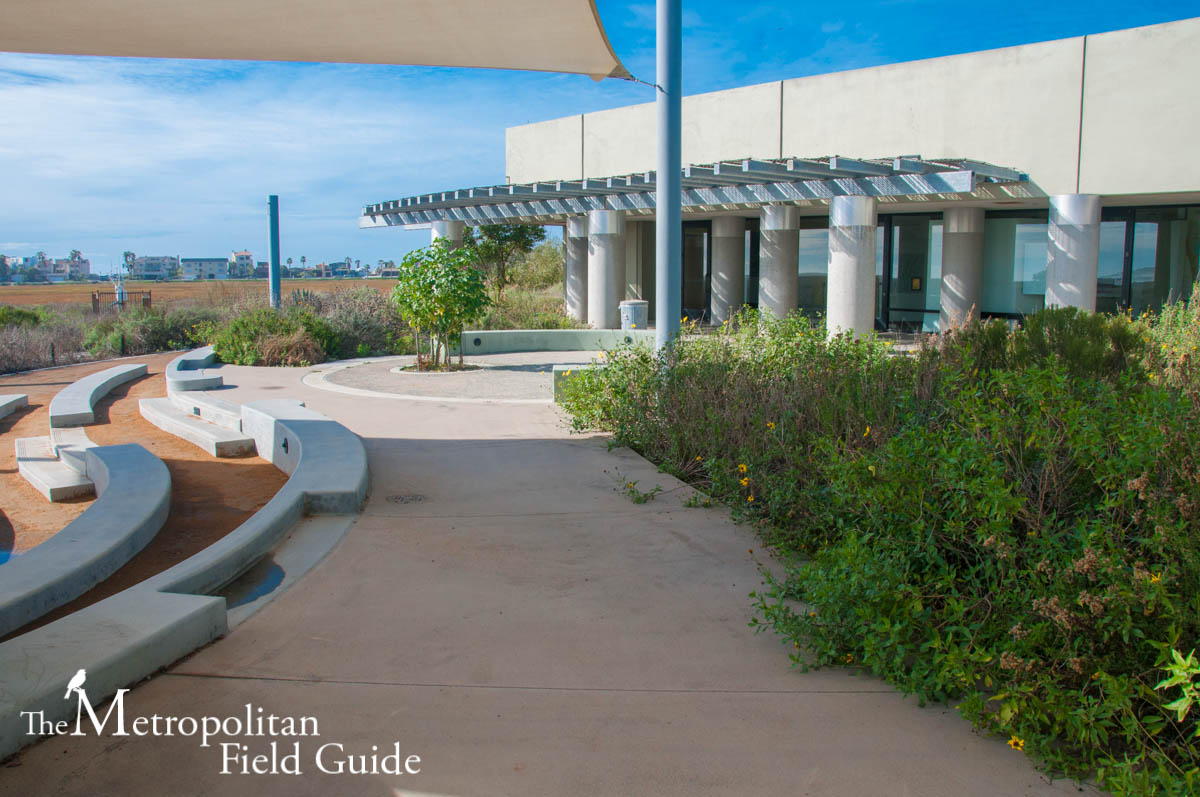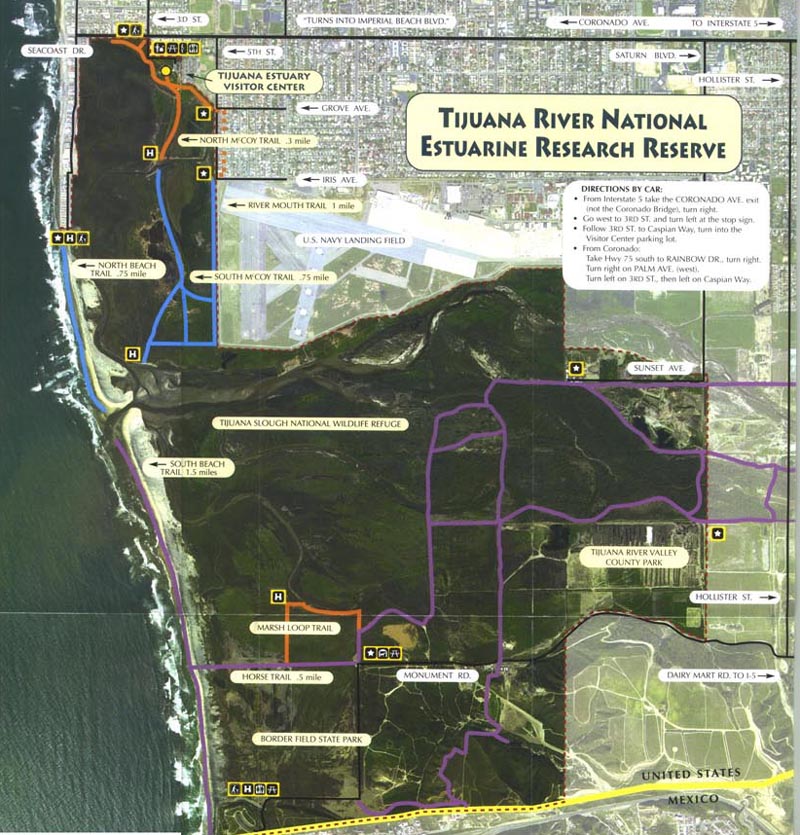The Tijuana River National Estuarine Research Reserve is 2,500 acres of coastal wetland located at the mouth of the Tijuana River in southern California. It’s located in the most southwestern point of the continental U.S., running along the United States – Mexico border. The estuary contains the Tijuana Slough National Wildlife Refuge, Border Field State Park, Tijuana River Valley County Park and is divided up among San Diego County property, San Diego City property and U.S. Navy lands and a half dozen different or so agencies are involved in management and use. It’s one of 27 estuarine reserves in the country, designated by the National Oceanic and Atmospheric Administration for education and research. The reserve is among the remaining 10% of southern California’s coastal wetland habitat. The northern portion of the reserve is surrounded by residential developments to the north, east and west and on the very northern portion of the reserve sits the Tijuana Estuary Visitor Center.
The area around the Visitor Center is a five-acre native plant garden which offers an example of native habitats and plants of the coastal plateaus of southern California. However, a short time ago, in 1980, the site of the Visitor Center was an industrial dump. The site was plagued with old cars, trash and asphalt. Several years of volunteer cleanup, installation of irrigation and intensive planting transformed the site into a native plant garden. In 2007 the garden won an “Orchid Award” from the San Diego Architectural Foundation’s annual Orchids & Onions as did the Visitor Center itself.
The garden has multiple habitats including coastal sage scrub, coastal dunes, riparian and salt marsh. The coastal sage scrub consists of many shrubs that are adapted for the low rainfall of the southern California climate, and have characteristics such as shallow roots as well as being deciduous. Some of the native plants from this habitat include Black sage (Salvia mellifera), which attracts butterflies, and Flat-topped buckwheat (Eriogonum smithii).
The coastal dunes plants are characterized by being adapted to strong winds, salt spray and sand. The plants of the coastal dunes are valuable for the wetlands because they form mats of vegetation which help to protect the dunes from wind and waves. A couple of notable coastal dune plants are Sand verbena (Abronia maritima), which provides shelter for lizards, Beach Burweed, and Beach evening-primrose (Oenothera drummondii), which also attracts butterflies.
The riparian habitat in the garden was created by directing the stormwater runoff from the street into a swale where the pollutants are filtered before the water reaches the estuary waters. Plants for riparian habitats include cottonwood and willow trees and are notable because they like water and can survive in standing water for a period of time. Another plant found in the riparian zone is the grass-like Spiny rush (Juncus acutus). The riparian habitat provides water for birds as well as perches for singing and nesting sites. The vegetation also provides habitat for insects and a water source for mammals and reptiles.
The final habitat in the garden is the salt marsh where plants have grown adapted to the salt water influence such as Sea Blite (Suaeda californica).
Other important plants include Lemonadeberry (Rhus integrifolia) which produce fruit that many animals eat including mammals, songbirds and game birds. Toyon (Heteromeles arbutifolia) is another berry producting shrub that also provides fruit for birds. Yucca (Yucca schidigera, Y. whipplei) is a plant that is of historic cultural importance as well as important for the sole pollinator of Yuccas, the Yucca Moth (Tegeticula sp., Parategeticula sp.). The Yucca Moth pollinates the plants while at the same time leaving eggs, which when hatched into caterpillars, feed on the plants seeds. California buckwheat (Eriogonum fasciculatum) is a shrub with dense flowers which are favorites to pollinators such as bees and butterflies, and is a larval host plant for two species, the Lupine Blue and Electra buckmoth.
The Visitor Center sits in the center of the garden with paths leading out to a path that circles the entire garden. From the south side of the garden the hills of Mexico and the Coronado Islands can be seen to the south. Around the back of the building is a paved amphitheater and sidewalks, but the plants seem to be trying to take over that space, hanging over every edge onto the pavement and right up to the building of the Visitor Center. The garden is quite an experience to someone not from the Southwest because of the dry landscape, use of cactus and a somewhat more sparse and brown plantings than many may be used to. However, it’s still full of color and wildlife and interesting textures. It’s an excellent example of adapting native habitats and plants and turning it into a garden. This space is not only a demonstration garden, but used for birdwatching, classes, nature walks and other gatherings.
The landscape of this garden has changed dramatically since 1980 when it was an industrial dump. Today, thanks to all of the work, the invasive weeds are disappearing, the soil is coming back to life and wildlife has returned. Now there is evidence of not only birds, insects and lizards, but also skunks, opossums, rabbits and many species of birds not previously found here.
View more images here.
Further Reading::
Tijuana River National Estuarine Research Reserve
Your Native Plant Garden:: Much of the information came from this brochure picked up at the Visitor Center, but unfortunately I was unable to find a digital copy of this excellent brochure.








Thanks for a wonderful post.
Minor fact-check: wouldn’t the southwestern-most point of the *continental* United States be here? The southwestern-most point in the US as a whole must surely be in Hawaii, like South Point of the Big Island or Kure Atoll.
You’re absolutely correct Jason, thank you very much for pointing that out. I’ve fixed the text, thank you for reading!
Kelly, I enjoy these profiles.
I am interested in the riparian habitat created via diverting street runoff. Do you have any more information on this design feature?
Georgia, I couldn’t find any more information about the design unfortunately, but I started to dig around looking for the firm who won the Orchid Award for it, which is AEREA landscaping. I couldn’t find much information about the firm, but I did find the name Leslie Ryan linked to it, which happens to be a professor I had. I contacted her and asked her to come comment here.